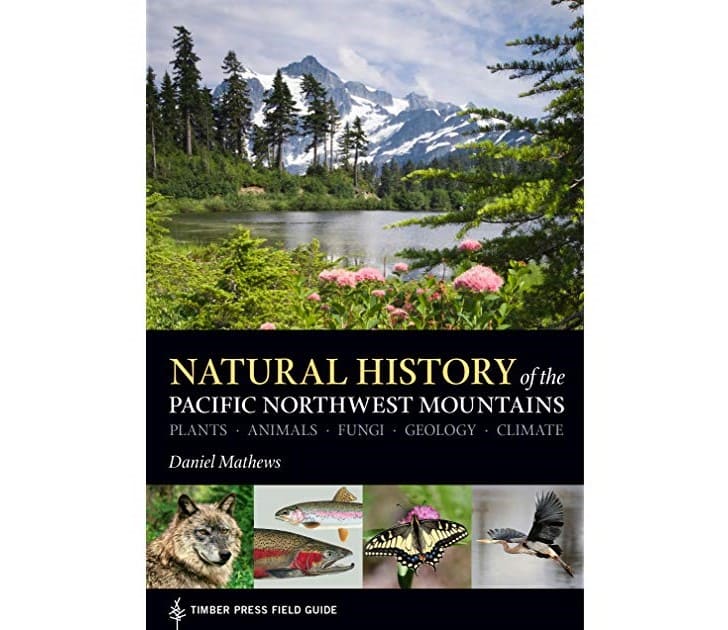
“Natural History of the Pacific Northwest Mountains” reviewed
Many years ago, sitting in a subalpine meadow below Slate Peak in the North Cascades, Art Kruckeberg told me “a naturalist is an ecologist in short pants.” That began a long, rambling discussion about natural history, field ecology, trail snacks, Methow Valley place names, simple tools for the complete naturalist, and ultimately, what books are worth carrying in your pack. Daniel Mathews Natural History of the Pacific Northwest Mountains is one of those books.
Mathews’ magnum opus is a love poem to the creatures that inhabit the mountains and rivers of Washington, coastal Oregon and southwestern British Columbia. This book is much more than just a field guide, it’s a series of lessons in how to pay attention to the amazing diversity of the natural world. I’ve pulled it out of my pack on a misty summit and read it by headlamp in my tent.

This unique volume is a much expanded and updated third edition of Cascade Olympic Natural History first published in 1992. The geographic range has been expanded to include the mountains of Vancouver Island, the British Columbia Coast Range and Northwest Oregon, as well as the Olympics, North Cascades and southern Cascades in Washington. While these ranges have different geologic stories, the rich species diversity they share links them well in
this field guide.
Dan Mathews shares tips for finding and identifying over 950 species, while describing the landscapes they inhabit from the mountains to the sea. Striking photographs combine with excellent descriptions and compelling sidebar stories that bring these wild mountains alive. From rich evocations of the land, to life histories of early naturalists, to musings about slug sex and the impacts of climate change, each page of this book drew me deeper in. In one packable volume, it’s both introduction and graduate course in Northwest natural history.
This book stretches far beyond the usual “field guide” to include a broad and surprisingly deep swath of natural history: plants, animals, fungi and geology, with additional sections on climate (and climate impacts on Northwest species), naming (including recent taxonomic upheaval in our favorite plant families), and over 60 fascinating mini-essays on everything from historical Northwest naturalists to alpine landforms, plant succession, timberline, gopher teeth, weeds, coprophagy, animal sonar, torpor and hibernation, pheromones, and the sweet aromas of cedar.
Over half the book is devoted to plants, with broad coverage and excellent descriptions, natural history notes and photographs of conifers, flowering trees, shrubs and herbs, ferns, clubmosses, horsetails, mosses and liverworts. Coverage of fungi and lichens is good but more limited. Mammals and birds are well treated, with an excellent selection of our most common and interesting species. The selections of reptiles, amphibians and fish are more limited, but adequate for the amateur naturalist. Insects are much more fully treated than in the earlier editions, and dragonflies are now well represented. The geology section is particularly well done, with a well written and understandable description of the past 250 million years of mountain forming, geomorphology, terranes, volcanoes and rock types of our wild neighborhood.
Natural History of the Pacific Northwest Mountains is well designed for the field with 800 color photos, 215 illustrations and 4 maps wrapped in a tough water-resistant cover. The only downside, and it’s to be expected in a book this thorough, is its rather hefty mass – at just over two pounds it’s a weighty addition to a pack that might also contain Pojar, Sibley, Pyle and Paulson.
I commend Timber Press for actively pursuing their mission to share the wonders of the natural world by adding Natural History of the Pacific Northwest Mountains to their Field Guide Series which now includes Birds, Trees and Shrubs, Mushrooms, Insects, Wildlife Tracking, and Medicinal Plants.
Pick a copy up today at your local independent bookstore or help support youth education in the North Cascades by ordering from North Cascades Institute’s new online store: www.ncascades.org/shop. And then get outside and explore our wild mountains!
Books for the Pack
Before our journey into mountains
we choose by size and weight
the books that we place in our packs.
I pick four, and wedge them tight
between climbing gear and cook pots:
Basho’s Haiku, Mathews’ Natural History,
Sund’s Ish River, Pyle’s Butterflies.
What rests on the pages is weightless.
— Saul Weisberg
Headwaters: Poems and Field Notes. Pleasure Boat Studio, 2015

